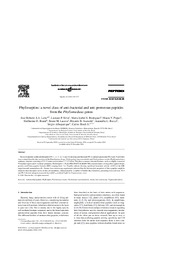Phylloseptins: a novel class of anti-bacterial and anti-protozoan peptides from Phyllomeduza genus.
Phylloseptins: a novel class of anti-bacterial and anti-protozoan peptides from Phyllomeduza genus.
Author(s): LEITE, J. R. S. A.; SILVA, L. P.; RODRIGUES, M. I. S.; PRATES, M. V.; BRAND, G. D.; LACAVA, B. M.; AZEVEDO, R. B.; BOCCA, A. L.; ALBUQUERQUE, S.; BLOCH JUNIOR, C.
Summary: Six novel peptides called phylloseptins (PS-1, -2, -3, -4, -5, and -6) showing anti-bacterial (PS-1) and anti-protozoan (PS-4 and -5) activities were isolated from the skin secretion of the Brazilian tree-frogs, Phyllomedusa hypochondrialis and Phyllomedusa oreades. Phylloseptins have a primary structure consisting of 19?21 amino acid residues (1.7?2.1 kDa). They have common structural features, such as a highly conserved N-terminal region and C-terminal amidation. Phylloseptin-1 (FLSLIPHAINAVSAIAKHN-NH2) demonstrated a strong effect against Gram-positive and Gram-negative bacteria (MICs ranging from 3 to 7.9 µM), without showing significant hemolytic activity (<0.6% at the MIC range) towards mammalian cells. Atomic force microscopy experiments indicated that the bacteriolytic properties of these peptides might be related to their disruptive action on the cell membrane, characterized by a number of bubble-like formations, preceding every cell lysis. PS-4 and PS-5 showed anti-protozoan activity with IC50 at about 5 µM for Trypanossoma cruzi.
Publication year: 2005
Types of publication: Journal article
Keywords: Phyllomedusa hypochondrialis, Phyllomedusa oreades
Observation
Some of Embrapa's publications are published as ePub files. To read them, use or download one of the following free software options to your computer or mobile device. Android: Google Play Books; IOS: iBooks; Windows and Linux: Calibre.
Access other publications
Access the Agricultural Research Database (BDPA) to consult Embrapa's full library collection and records.
Visit Embrapa Bookstore to purchase books and other publications sold by Embrapa.

